Purpose of Bowtie Analysis in Aviation SMS

Bowtie analysis is one of the best aviation risk management tools to communicate risk and demonstrate commitment to safety.
Although not universally shared, I've seen that about 10% of smaller operators in the 100 to 500 employee range believe that bowtie is the best way to communicate operational risk and satisfy aviation safety management system (SMS) auditors. These "bowtie adherents" are usually providing services to the oil and gas industry. Losing a contract with an oil and gas company could potentially cost them millions of dollars, hence the popularity of the bowtie among aviation service providers.
Related Aviation SMS Bowtie Articles
- 6 Essential Rules for Bowtie Analysis in Aviation SMS
- 3 Ways You’re Not Using the Bowtie in Aviation SMS
- 4 Best Uses of Bowtie Method in SMS Risk Management – Do You Use Them?
Your bowtie covers all essential risk management basics, from root causes to impacts and risk controls. Aviation SMS that uses bowtie analysis:
- greatly increase the effectiveness of the SMS risk management processes;
- increase awareness to upper management of their risk management capabilities; and
- offer assurance to the accountable executive that risk is actively managed by ALARP.
Challenges Using Bowtie Analysis in Aviation SMS
Learning how to perform a bowtie analysis is daunting - hence why more companies don’t use this highly visual risk management tool. Another drawback of bowtie analyses is that one can easily get lost in the weeds, i.e., they don't know when to stop the seemingly never-ending analysis. Subsequently, the bowtie loses its effectiveness as a communication and risk management tool when the final analysis requires an entire wall to print out and display.
If you can keep your bowtie under control, it provides an excellent snapshot of hazards' risks and controls.
If you are not yet using bowtie analysis, here’s how flexible it can be in real-world use cases:
- Risk scenario analysis;
- Demonstrating potential costs of a scenario to executive management;
- Demonstrate the importance of compliance;
- Teach what risk management is;
- Safety incident management;
- Risk control and root cause analysis; and
- Safety event summary.
All of this information is great, but if you don’t know how to create a bowtie then it doesn’t help you. Or if you don't have the tools to easily create an easy-to-read/understandable bowtie, then you will be simply "spinning your wheels" and dreaming of greener pastures.
Don’t be afraid of failure when starting to create and experiment with bowtie analysis. Creating quality bowties will take practice and the right tools. One could theoretically create a bowtie on paper or using MS Excel. The more effective tools are either stand-alone bowtie products, like Bowtie XP, or embedded within aviation SMS database software.
There are several advantages of having the bowtie tools within your aviation SMS database, including:
- easy access when the auditors come;
- access to identified hazards, risks, and risk controls in the database;
- ability to work on bowtie analysis in a collaborative, team-based environment;
- ability to access bowtie analyses anywhere you have Internet access; and
- reduced the number of software programs by one (you don't need a special bowtie software program when it is in your SMS database).
Once you learn the technology and are able to quickly create a bowtie, this will become a secret risk management weapon that you can employ when the situation warrants it. This usually occurs when auditors come calling and they want to see you demonstrate how you are monitoring the effectiveness of risk controls.
Here is a 5-step example walk-through of how to do bowtie analysis in aviation SMS.
Related Aviation SMS Database Articles
- What Is an Aviation Safety Database
- 5 Most Important Things to Know Before Buying Aviation SMS Database
- How to Choose the Best Aviation Safety Database Software
Our Bowtie Scenario

We will base our scenario on several real-world situations for a Runway Incursion. In our scenario:
- An Airbus nearly collides with a Boing 747 as it is taking off;
- The Airbus passed directly overhead of the 747, with an altitude of only 200 feet (~67 meters);
- Most passengers on the 747 witnessed the near-collision;
- The incident occurred at night;
- The Airbus was cleared for takeoff, but the 747 had been in breach of its taxi clearance and had moved on to the runway;
- The 747 flight crew did not hear the Airbus being given takeoff clearance;
- The 747 acknowledged the hold short clearance but did not clearly see the hold short line and had a hard time seeing it because of glaring runway lights. Also, the hold short line was not shown on the airport diagram;
- Moreover, the ASDE-X warning was noticed too late to stop the 747 from breaching;
- In the ensuing months, the situation resulted in lost revenue, lost stock value, bad press, and fines for the 747 airline company.
We will create a bowtie from the perspective of the 747 airline company.
Step 1: Establish Top Event – Point of Lost Control
Step one is the most critical step. You need to choose the Top Event. You will have a hard time choosing the Top Event if you don’t know what a risk actually is. Before proceeding, please quickly review or educate yourself if you don't completely understand the difference between hazards, risks, and risk controls. We have seen MANY safety professionals make simple mistakes due to an incorrect understanding of these common risk management definitions.
The Top Event is:
- The risk in the event;
- The point at which safety control is/was lost; and
- The point that threats lead to, and that eventually results in damages.
Take a moment to think about what the point of lost control is in our scenario. If you said that it was when the 747 breached the hold short point then you are correct.

This is the Top Event because this is the situation that pilots need to react to in order to regain control over safety.
Have You Read
- Difference Between Hazards, Risks & Control Measures in Aviation SMS
- How to Implement Effective Control Measures
- How to Evaluate and Justify a Risk Control in Aviation SMS
Step 2: Establish All Preceding Events to Root Cause Threats
Now what we need to do is work backward, listing each event step by step that leads to the incursion. As we list each event we ask, “But why?” Eventually, we are looking for the root cause of the threats. A good indication that you have arrived at root causes is when your answer to the question is, “Just because.”
With our scenario this root cause analysis would look like this:
- Pilot didn’t hear takeoff
- ASDE-X alert noticed late;
- Pilot didn’t see hole short line;
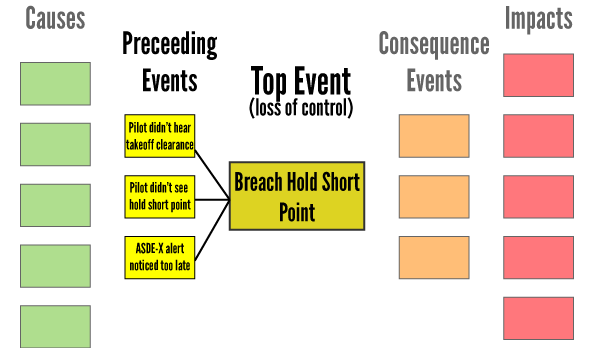
Now we need to consider the root cause threats that lead to the Preceding Events by asking "but why" about each event.
- Pilot Distraction;
- Glaring lights;
- Night;
- Airport diagram missing information; and
- Human Error.
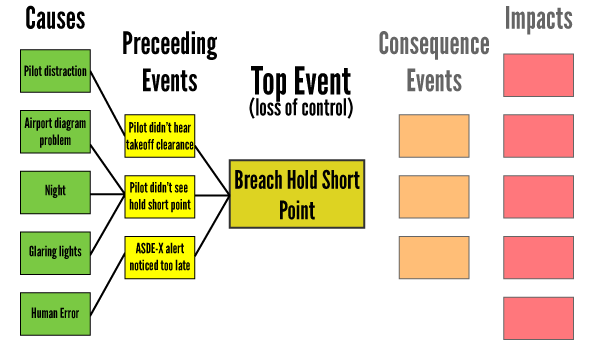
Notice that the threats tend to be nouns, and the events that follow tend to include verbs (“see” “noticed” and “hear”). We know that our root cause threats are correct because we can give no reasons for them - their answer to the "but why" is just because. Notice that distraction and Human Error are perfectly valid threats, as sometimes we simply are distracted or make mistakes for no “good reason.”
Step 3: Establish Consequences Following Top Event
Next we need to look at what the direct consequences of breaching the runway are. These consequences are the intermediary events before our Top Event and final Impacts, or damages. In our scenario, the direct consequences were:
- Rolled onto the runway;
- Reported in press; and
- Terrified passengers.
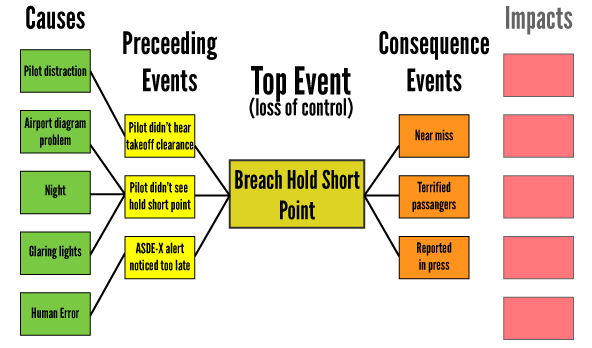
It’s important to distinguish between consequences and Impacts. Consequences do not cause Impact damages themselves but lead directly to damages.
Step 4: Establish All Impacts (Damages)
Impacts, or final consequences, are always characterized by damage. Damage could be to persons, equipment, reputation, money, etc. – anything that hurts your organization. Picking out damages is usually pretty easy. Can you pick out the damages of our scenario?
Here are a few:
- Fines;
- Reputation damage;
- Loss of stock value ($$ loss);
- Reduced passenger revenue; and
- Possible litigation.
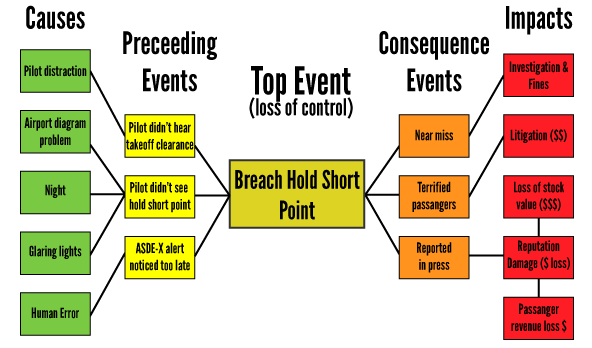
Each item causes an element of damage to the company.
Step 5: Insert Risk Controls Where Appropriate
The last step that is critical to bowtie analysis is to list your risk controls directly after each item to see how your risk controls failed. If you are unable to list a risk control, it’s a good indication that you need to implement one.
A few risk controls we can show as an example are:
- Preflight clearance checklist;
- GPS;
- Short field takeoff;
- Compensation packages; and
- PR Control.
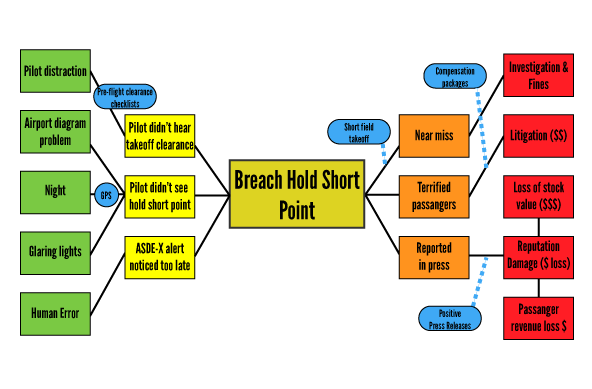
My example is a bit limited by space, but in actual practice, you will have more space to fit in your risk controls nicely. Moreover, your bowtie analysis will feature as many risk controls as possible, perhaps even several risk controls per item.
Related Articles on Aviation SMS Risk Controls
- What Is a Risk Control in Aviation SMS: Meaning, Purpose, Application
- Proactive Risk Controls vs. Mitigative Risk Controls in Aviation SMS
- FAA Part 5 Compliance | Safety Risk Management Risk Control Component
Final Thought: Adopting Bowtie Analysis Method
There are two approaches to creating your bowtie.
In the first method, your bowtie analysis may look different every time. Sometimes you may have more threats and following events, and sometimes your Top Event will lead almost directly to impacts. With this method, there’s no “right way” for a bowtie to look, so long as you capture the main elements of the situation.
However, many organizations find it much more comfortable to use a different method. With this alternative approach, you follow templates to keep bowtie analysis consistent both in how they look and how they are created. While this method does not allow a highly, flexible "output" or "deliverable" for each situation, it will be easier and less error-prone. Furthermore, when managers start studying and using bowties in their risk management decision-making processes, having consistent bowtie outputs allows for both quicker analysis and subsequent decision-making.
I think the best idea is to do what is most effective and safest for your organization.
An aviation safety database that has consistent, easy-to-understand bowtie features is definitely a bonus for every aviation SMS. Bowties can become complicated and Bowtie XP is very expensive software. If you can get a bowtie module in your aviation SMS database, you are one step closer to putting all your aviation risk management tools in one bucket.
Aviation SMS database software should have more than a bowtie tool. The best aviation SMS databases have user-friendly tools that address all SMS requirements, regardless of whether they are the requirements of:
- civil aviation authorities (FAA, EASA, Transport Canada, CASA);
- standards bodies (IATA, IS-BAO), or
- clients.
SMS Pro is considered the best by our clients who have already done extensive research on the available solutions. Learn why they have found SMS Pro to be the best SMS solution. SMS Pro is not a point solution, nor is it a group of disparate point solutions cobbled clumsily together. It is an integrated suite of tools with excellent SMS performance monitoring tools that can be used by the entire organization, not just the safety department.
Live SMS Pro Demo
Does it look like we are a good fit? Have questions? We serve all aviation industry segments AND ONLY aviation. This software was created for the aviation industry by aviation SMS database professionals.
Last updated in April 2025.






